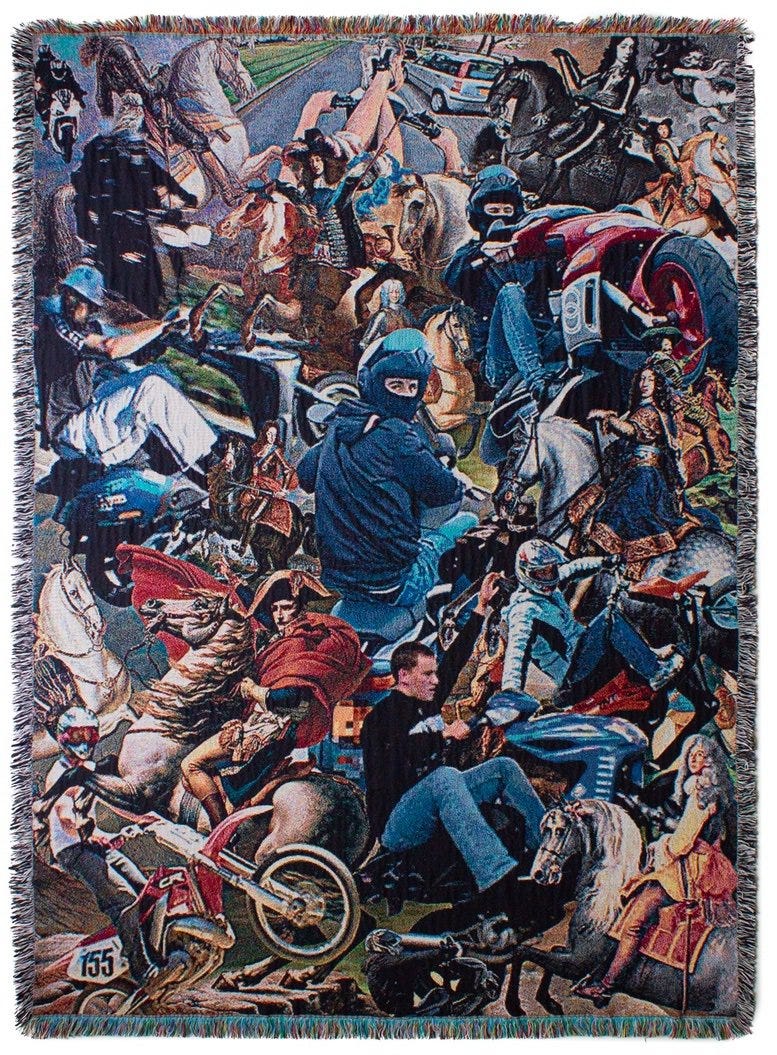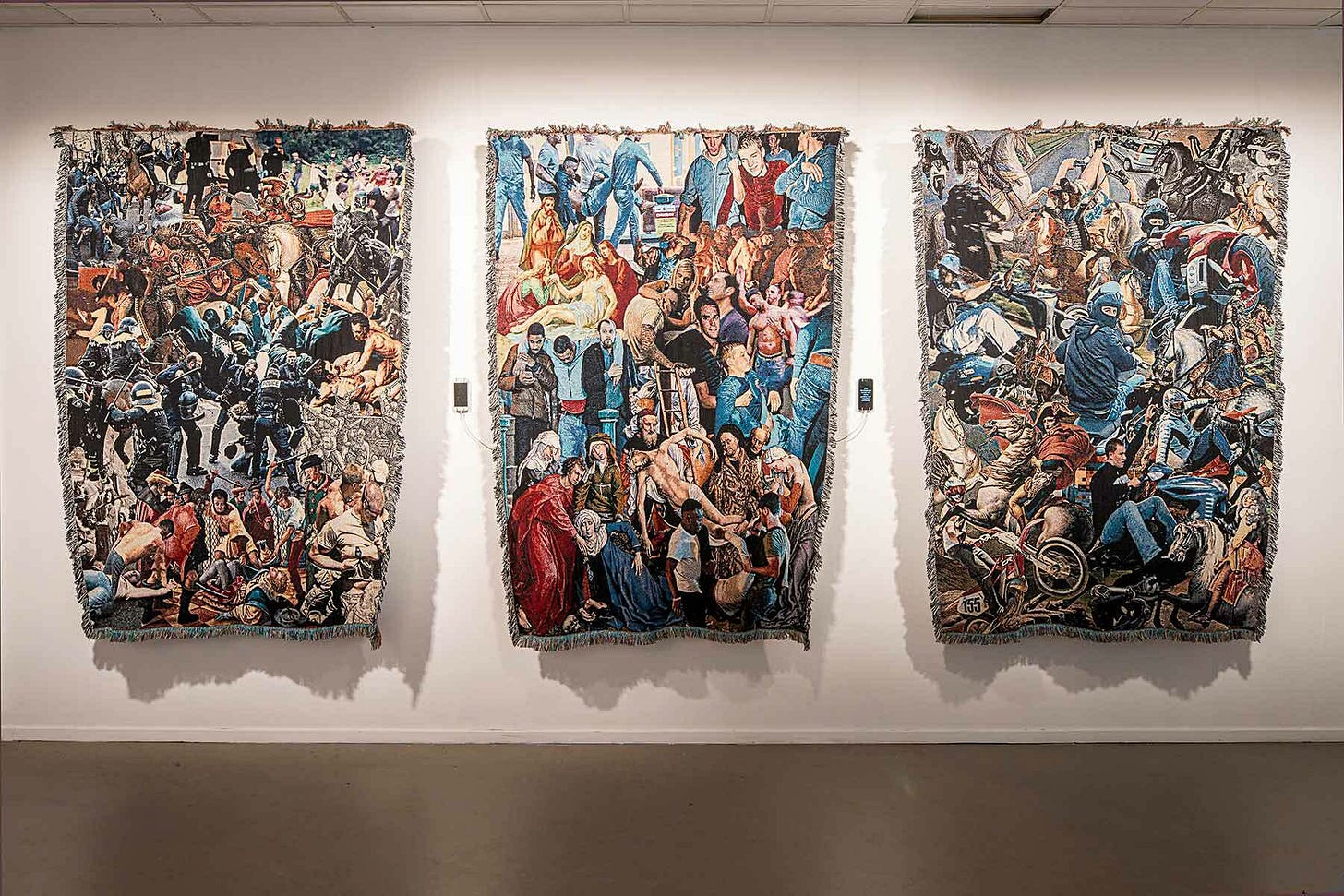#26 Jeroen van den Bogaert
Jeroen van den Bogaert is a graphic designer and co-founder of creative studio FCKLCK. Jeroen’s work departs from an ambiguous relationship with masculinity, that he encountered within himself and other young men around him. He describes this relationship as one that involves a dilemma.
Where did the silver lining in your work, masculinity, originate?
“During my Master’s, I was involved in maintaining an archive. In that archive, I explored historical art images alongside contemporary visuals, seeking comparisons. Two key elements always guided my search: symbolism and gesture. For instance, I have a piece depicting a historical painting of Jesus on the cross with contemporary images of drunken youth underneath. There’s no symbolic message as the two phenomena are unrelated. It’s the shared gesture that makes it visually interesting forme,injectingahumorous twist into classical culture. This is what I mean by gesture. If we consider the piece with the scooter, there’s also a gesture, but the focus is more on the symbolic message. It explores how riding a scooter is perceived as heroic, especially by boys, even though it doesn’t make much sense. I believe historical paintings of men on horses might have evoked a similar feeling. So, I had this archive, and for my graduation, I was asked to revisit it and explore prominent themes. That’s when I realized my inclination towards rebellious and explosive boyish behavior. I concluded that I wanted to incorporate this into my work. Itbroughtmebacktomyinitial thesis idea, exploring behaviors I knew had a negative impact. However, the focus shifted because I couldn’t articulate it well at that time.”
Would you say you understand “rebellious” behavior well?
“Yes, it’s kind of a double-edged sword. When I see someone doing a wheelie on the street, part of me thinks it’s cool, but at the same time, it’s kind of ridiculous. I think it also has to do with getting older. In your younger years, you’re developing yourself and doing things you know you shouldn’t, but who cares. As you age, you realize some actions limit the freedom of others, making you more aware of certain behaviors. My critical perspective on behavior has become more discerning, perhaps because of getting older. Looking back at my own youth, I realize there were moments when I went too far with friends. I chose to focus on boys because that’s my perspective. I don’t want to speak for others; I want to speak for myself. Someone once asked me during a show if in my work I’m creating a world where women don’t exist. They didn’t understand that I don’t intend to speak for women in my work. I can’t tell you what your teenage years as a woman were like. In hindsight, I regret not being able to incorporate that viewpoint into my thesis.”
Besides being an artist, you’re also the co-founder of FCKLCK Studio. Could you tell us more about the studio?
“We have a studio focused on strategy, design, and branding. We approach it from an artistic standpoint with a design perspective. What I mean is, we create visually challenging work. I’m the designer for the studio. Our goal is to produce challenging work in the design sector, outsideoftheconstraintsof commercial design. We aim toofferdistinctiveanduniquedesigns for brands that don’t conform to the market. People often want things they’ve already seen. It’s still a much more commercial approach than my personal work, but it aligns with my background. Before pursuing my Master’s at KABK, I worked for a branding studio. I left because I felt the work started to become too repetitive. Now it’s differentbecauseIhavecreative input, and it’s exciting to see our own company grow. We started at the kitchen table with a mini manifesto, and now, a year later, we have our own office.”
You have a new collaboration with Milk of Lime. How did that come about?
“Milk of Lime is run by Nico and Julia, both from the fashion academy here in Antwerp. Sometimes, I have leftover fabrics from woven tapestries that don’t meet my exhibition standards. So, I had some fabrics left and wanted to see what could be done with them. That’s when I contacted Nico, and he was interested. Eventually, we started talking, and they proposed a more extensive collaboration. In recent weeks, we’ve been collaborating to create new tapestries. Which will be used as material for crafting garments in their upcoming collaboration. The intention is to feature these garments in their next runway show and subsequently explore the possibility of exhibiting them alongside the wall tapestries in various locations.”
Do you see yourself more as an artist or a designer?
“I’m not sure about titles or labels. I understand their use within corporate structures, but I find them less relevant to how I percieve myself. From my perspective, titles like ‘Artist’ and ‘Designer’ seem broad and somewhat empty. I’m more focused on the actual work I’m engaged in. Which currently involves the creation of tapestries.”






